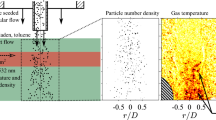Abstract
A fluorescence image analysis procedure to determine the distribution of species concentration and density in a gas flow is proposed. The fluorescent emission is due to the excitation of atoms/molecules of a gas that is intercepted by an electron sheet. The intensity of the fluorescent light is proportional to the local number density of the gas. When the gas flow is a mixture of different species, this proportionality can be used to extract the contribution associated with the species from the spectral superposition acquired by a digital camera. In particular, the fact is exploited such that the ratio between a pair of color intensities takes different values for different gases and that different linear superpositions of different color intensities yield a ratio that varies with the species concentration. This leads to a method that simultaneously reveals species concentrations and mass density of the mixture. For the proper working of a continuous electron gun in a gas, the procedure can be applied to gas flow where the pressure is below the thresholds of 200∼300 Pa and the number density is no greater than 1023 m−3. To maintain the constancy of the emission coefficients, the temperature variation in the flow should be inside the range 75–900 K (above the temperature where the probability to meet disequilibrium phenomena due to rarefaction is low, below the temperature where visible thermal emission is present). The overall accuracy of the measurement method is approximately 10%. The uncertainty can vary locally in the range from 5 to 15% for the concentration and from 5 to 20% for the density depending on the local signal-to-noise ratio. The procedure is applied to two under-expanded sonic jets discharged into a different gas ambient—Helium into Argon and Argon into Helium—to measure the concentration and density distribution along the jet axis and across it. A comparison with experimental and numerical results obtained by other authors when observing under-expanded jets at different Mach numbers is made with the density distribution along the axis of the jet. This density distribution appears to be self-similar.












Similar content being viewed by others
References
Agrawal AK, Alammar KN, Gollahalli SR (2002) Application of rainbow schlieren deflectometry to measure temperature and oxygen concentration in a laminar gas–jet diffusion flame. Exp Fluids 32:689–691
Alammar K, Agrawal AK, Gollahalli SR, Griffin D (1998) Application of rainbow schlieren deflectometry for concentration measurements in an axisymmetric helium jet. Exp Fluids 25:89–95
Ashkenas H, Sherman FS (1966) The structure and utilization of supersonic free jets in low density wind tunnels. In: de Leeuw JH (ed) Rarefied gas dynamics. Academic, New York, pp 84–105
Belan M, Tordella D, De Ponte S (2001) A system of fast acceleration of a mass of gas for the laboratory simulation of stellar jets. In: 19th ICIASF, Cleveland
Belan M, De Ponte S, Massaglia S, Tordella D (2004) Experiments and numerical simulations on the mid-term evolution of hypersonic jets. Astrophys Space Sci 293(1–2):225–232
Belan M, De Ponte S, Tordella D (2006) Simultaneous density and concentration measurements on hypersonic jets, Abstract, EFMC6 KTH. In: Euromech fluid mechanics conference 6, Royal Institute of Technology, Stockholm
Brown LO, Miller N (1957) α-Ray induced luminescence of gases. Trans Faraday Soc 53:748
Bütefisch KA, Vennemann D (1974) The electron-beam technique in hypersonic rarefied gas dynamics. Prog Aerosp Sci 15:217–255
Cattolica RJ (1988) Advanced optical diagnostics in hypersonic research. In: Summary of discussions at the 11th meeting of the Sandia cooperative group on the aerothermochemistry of turbulent combustion, USA, vol 42
Cattolica RJ, Robben F, Talbot L, Willis DR (1974) Translational nonequilibrium in free jet expansions. Phys Fluids 17(10):1793–1807
Cattolica RJ, Gallagher R, Anderson JB, Talbot L (1979) Aerodynamic separation of gases by velocity slip in free jet expansions. AIAA J 17(4):344–355
D’Ambrosio D, De Socio LM, Gaffuri G (1999) Physical and numerical experiments on an under-expanded jet. Meccanica 34:267–280
Dankert C, Cattolica R, Sellers W (1993) Local measurement of temperatures and concentrations: a review for hypersonic flows. AGARD, theoretical and experimental methods in hypersonic flows 10
Gochberg LA (1994) The electron beam fluorescence technique in hypersonic aerothermodynamics. In: AIAA, 18th aerospace ground testing conference, Colorado Springs, CO, USA
Grisch F (2000) Molecular diagnostics for the study of hypersonic flows. ONERA report. Dept. Mesures Physiques, Chatillon, France
Hillard ME, Ocheltree SL Storey RW (1970) Spectroscopic analysis of electron-beam-induced fluorescence in hypersonic helium flow. NASA technical note TN D-6005
Kobayashi H, Nakagawa T, Nishida M (1984) Application of laser interferometry to density measurements in free jets. Trans Jpn Soc Aerosp Sci 27:184–192
Lutfy FM, Muntz EP (1999) Spectroscopic survey of gases found in hypersonic flows using pulsed electron beam fluorescence. In: 35th AIAA/ASME/SAE/ASEE joint propulsion conference and exhibit, Los Angeles, CA, USA
Muntz EP (1968) The electron beam fluorescence technique, AGARDograph 132
Nishida M, Nakagawa T, Kobayashi H (1985) Density contours of a supersonic free jet. Exp Fluids 3:181–183
Price L, Williams WD, Powell HM (1992) Electron beam fluorescence measurements in the Boeing hypersonic shock tunnel. In: NASA Langley Research Center, The 1992 NASA Langley Measurement Technology Conference: measurement technology for aerospace applications in high-temperature environments, pp 305–320
Wehrmeyer JA (2006) Pulsed electron beam spectroscopy of N +2 for temperature and density measurement. In: 44th AIAA aerospace sciences meeting and exhibit, Reno, Nevada, USA
Yildirim BS, Agrawal AK (2005) Full-field measurements of self-excited oscillations in momentum-dominated helium jets. Exp Fluids 38:161–173
Young WS (1975) Derivation of the free-jet Mach disk location using the entropy-balance principle. Phys Fluids 18(11):1421–1425
Author information
Authors and Affiliations
Corresponding author
Rights and permissions
About this article
Cite this article
Belan, M., De Ponte, S. & Tordella, D. Determination of density and concentration from fluorescent images of a gas flow. Exp Fluids 45, 501–511 (2008). https://doi.org/10.1007/s00348-008-0493-5
Received:
Revised:
Accepted:
Published:
Issue Date:
DOI: https://doi.org/10.1007/s00348-008-0493-5




